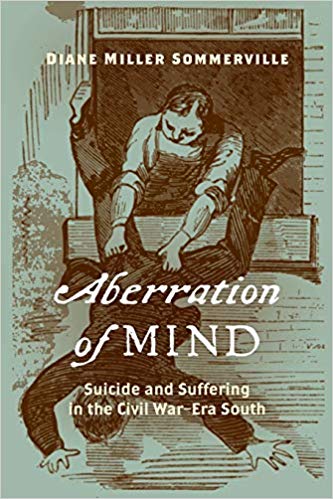In Aberration of Mind, Diane Miller Sommerville examines hundreds of individual instances of suffering in the wartime and postwar South to reveal the ways the Civil War traumatized Southerners—and how that suffering varied across race and gender in its experience and meaning. Sommerville explains how attitudes about suicide, before the Civil War a violation of Protestant religious and cultural mores, transformed through war along racial and gender lines. According to Sommerville, suicide in the postwar South became an expression of white superiority—an understandable, even noble response to the devastation of defeat and black freedom. Suicide and suffering among freedpeople confirmed for whites their unsuitability for the burdens of freedom. In turn, Sommerville argues that a complete understanding of the New South depends on a deeper investigation of the emotional and psychological damage wrought by the war and the dislocations and disruptions of Reconstruction. Sommerville suggests that an ex-Confederate “community of suffering” drew the emotional and psychological boundaries of the New South along racial and political lines, sanctifying white trauma and delegitimizing black suffering (13).
Sommerville divides her book into three thematic sections. The first part covers Confederate men and women during the war. Sommerville argues that for soldiers, fear of cowardice or failure on the battlefield, often coupled with youth and naiveite, exerted extreme pressures on their identity as martial men. Suicide offered soldiers the control, mastery, and honor the war threatened or denied. Over time, as soldier suicides mounted, Southerners destigmatized the act, reinterpreting self-murder not as sinful weakness, but as courageous sacrifice for the new nation.
For white women on the home front, wartime suffering often centered on the family and children, “familiar, mundane pressures” that were amplified in war by new, onerous obligations and responsibilities. Managing household (often slave) labor, acquiring food, and caring for children prompted psychological crises and sometimes suicidal ideation (50). Downplaying the defiance of “secesh” women familiar in Lost Cause ideology, Sommerville sees pervasive weariness, mental illness, and trauma beneath white women’s wartime experiences.
The second section examines black Southerners’ suffering during slavery and freedom. Rejecting the “resistance model” of scholars like Kenneth Stampp, who often abstracted slave suicide as the ultimate act of resistance intended to deprive the master of capital and labor, Sommerville proposes a “neo-abolitionist” approach, emphasizing mid-nineteenth century arguments that slave suicide was a rational and human response to barbarous cruelty (94-98). Tactile fears of marriage dissolution, sale of children, corporeal punishment, and sexual assault produced suffering that men and women experienced in personal, intimate ways. Suicide was “peace, not retribution,” Sommerville concludes (118). As the historian Jim Downs has shown, freedpeople also suffered greatly from disease, dislocation, and exploitation— suffering that whites insisted was proof of blacks’ unsuitability to freedom. Utilizing asylum records and clinical diagnoses, Sommerville shows how white physicians and racial “experts” turned to antebellum tropes of black incompetence and inferiority to frame black suicide as a symptom of broader degeneration among freedpeople unprepared for white “civilization.” Sommerville emphasizes the Freedmen’s Bureau’s role in forcing white asylums to admit black patients, but concludes that institutionalization only reinforced the idea that suicidal blacks were either clinically insane or suffering from freedom-induced mania.
The third section explores white men and women in the postwar South. The experience of suffering and incidence of suicide proceeded along gendered lines. Nineteenth-century notions of manhood dictated that white men provide for their families and exert control and mastery in public and private spheres. Widespread economic collapse, political weakness, and debilitating physical injuries emasculated white men and produced emotional and psychological trauma in the postwar South. Their suicides rippled through families and communities, spreading grief, destitution, and despair, particularly for women and children. Debt, hunger, abandonment, marital abuse, and the loss of children crippled many white southern women, undermining if not exploding the myth of the indominable “steel magnolia.” Ultimately, and out of necessity, the pulpit and the press secularized the act of suicide itself, downplaying sinfulness for compassion, empathy, and honor.
The price of entry for Sommerville’s book is a certain comfort with anecdotal and impressionistic evidence. Sommerville admits the study is largely “grounded in conjecture,” since, as she reasons, analysis of invisible and highly personal struggles and traumas cannot always rely on clear texts. Her focus on individual cases and lived experiences necessarily narrows her analysis, and she relies on “granular interrogation” of these sources to expose the many different stressors that contributed to suicide or mental anguish (198, 7). Her interdisciplinary approach is crucial, and she weaves neurobiology, psychology, and sociology into the study in effective ways, filling in gaps in the records with informed speculation. While the causes of suicide can never be definitive, Sommerville manages to recreate the experiences of suffering, and possible physiological disorders, that helps explain how people in the past responded to trauma.
Sommerville’s focus on the South raises important comparative questions, a point she acknowledges. Without a companion study of the North, in particular the Northern home front, it is difficult to confirm her insistence that Southern white men and women had “considerably greater” emotional suffering during and after the Civil War (79). True, the South experienced the sting of defeat, widespread physical destruction, and more acute postwar socioeconomic and political anxieties than the North. But many of the sources of mental anguish she describes, like the loss of a son, father, or husband; the postwar epidemics of opiate and alcohol abuse; and the appearance of trauma-induced psychological disorders were national phenomena. The depth of Sommerville’s study relieves her of any obligation for a comparative approach, but it will be interesting to see how other scholars build upon the methods and conclusions of this excellent work.
Elias J. Baker is a Ph.D. candidate in the Arch Dalrymple III Department of History at the University of Mississippi.





